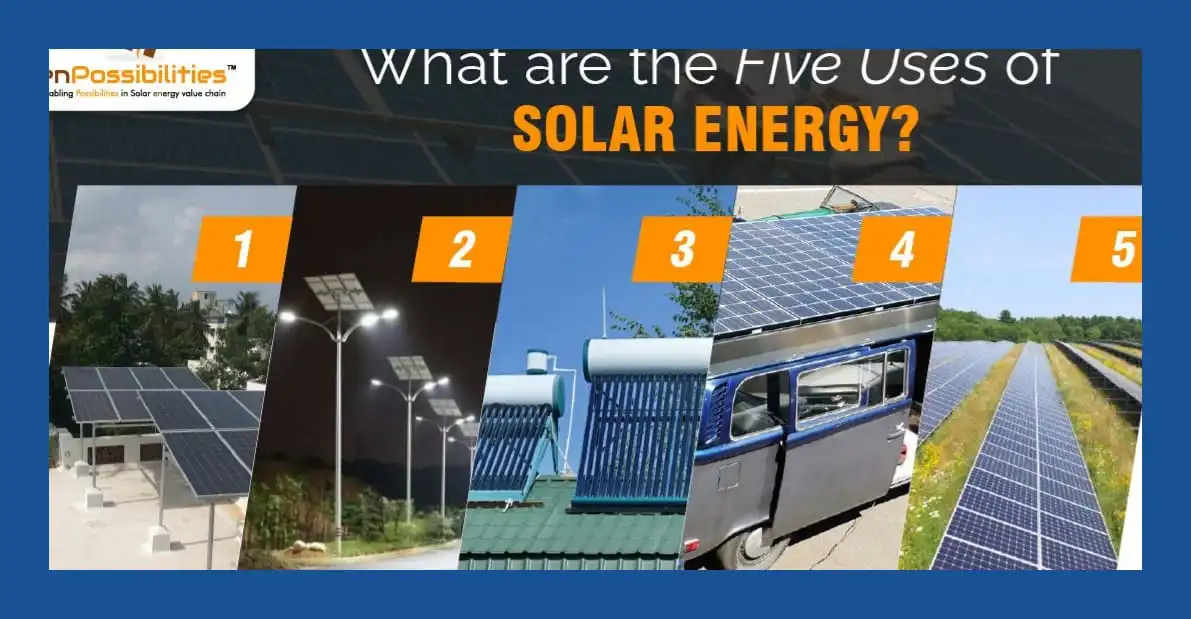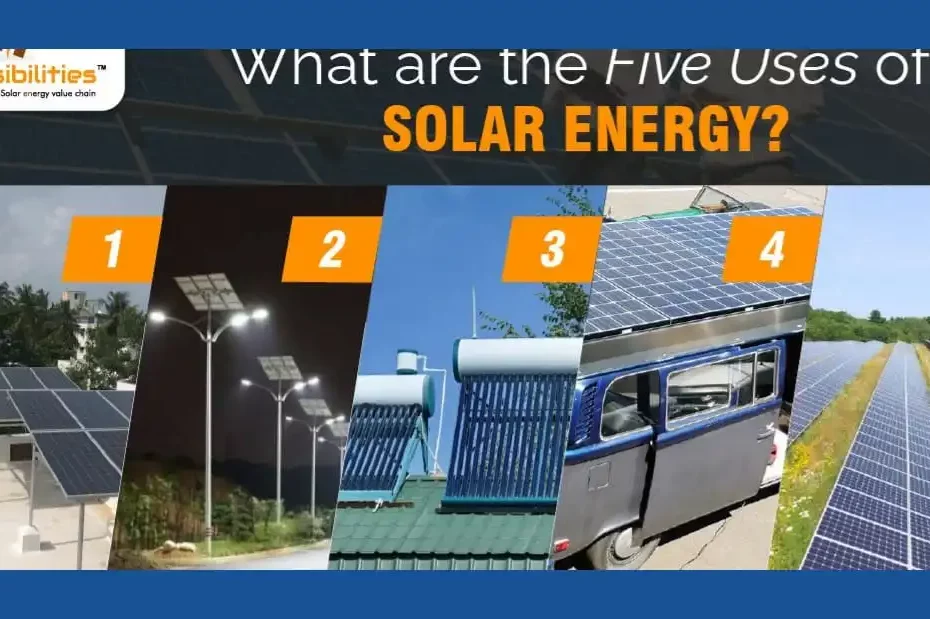
Sure! Here’s a detailed explanation for each heading on the uses of solar energy:
1. Electricity Generation
Photovoltaic (PV) Cells
Photovoltaic cells, or solar cells, are the most recognized technology for converting sunlight into electricity. These cells are made from semiconductor materials, typically silicon, which exhibit the photovoltaic effect. When sunlight strikes the cell, photons are absorbed by the semiconductor material, causing electrons to be knocked loose and flow through the material, generating an electric current. PV systems can range from small-scale residential setups to large-scale solar farms generating electricity for entire communities.
Residential PV systems are often installed on rooftops and can significantly reduce a household’s reliance on grid power. These systems are typically grid-tied, meaning they connect to the local electricity grid, allowing users to draw power from the grid when solar generation is insufficient and feed excess power back into the grid. On a larger scale, solar farms use arrays of PV panels to generate electricity that is distributed through the grid. Advancements in PV technology, including improvements in efficiency and cost reduction, have made solar electricity increasingly competitive with other energy sources.
Solar Thermal Power
Solar thermal power systems harness the sun’s energy to produce heat, which is then used to generate electricity. These systems use mirrors or lenses to concentrate sunlight onto a small area, creating intense heat. This heat is used to produce steam from water, which drives a turbine connected to a generator. There are different types of solar thermal power systems, including parabolic troughs, solar towers, and dish systems.
Parabolic troughs use long, curved mirrors to focus sunlight onto a receiver tube running along the length of the trough. The concentrated heat is transferred to a heat transfer fluid, which is then used to produce steam. Solar towers use a large field of mirrors, called heliostats, to focus sunlight onto a central receiver mounted on a tower. The concentrated sunlight heats a fluid in the receiver, which produces steam to drive a turbine. Dish systems use a dish-shaped reflector to concentrate sunlight onto a receiver located at the focal point of the dish, generating high temperatures to drive a Stirling engine or another type of generator.
Concentrated Solar Power (CSP)
Concentrated Solar Power (CSP) is a technology that uses mirrors or lenses to focus a large area of sunlight, or solar thermal energy, onto a small area. This concentrated light is converted into heat, which drives a heat engine (often a steam turbine) connected to an electrical power generator. CSP is typically used in large-scale power plants and is suitable for regions with high direct sunlight.
CSP systems are distinct from PV systems because they rely on direct sunlight rather than diffuse sunlight, making them more effective in sunny climates. CSP technology includes several different configurations, such as parabolic troughs, solar power towers, and dish Stirling systems. CSP can provide a stable and reliable source of electricity, and in some cases, can incorporate thermal storage to provide power even when the sun isn’t shining.
2. Heating Applications
Solar Water Heating
Solar water heating systems use solar collectors to absorb sunlight and convert it into heat. This heat is then transferred to water in a storage tank, providing hot water for domestic use. There are two main types of solar water heating systems: active and passive.
Active solar water heating systems use pumps and controls to move the heat-transfer fluid between the solar collectors and the storage tank. These systems can be divided into two types: direct and indirect. Direct systems heat the water that will be used directly, while indirect systems use a heat-transfer fluid that is circulated through the collectors and then through a heat exchanger to transfer heat to the water.
Passive solar water heating systems rely on natural convection and gravity to move the water or heat-transfer fluid. These systems are simpler and less expensive than active systems but may be less efficient in some situations. Solar water heaters can significantly reduce energy bills and are especially effective in sunny regions.
Solar Space Heating
Solar space heating systems use solar collectors to capture and convert sunlight into heat for warming indoor spaces. There are two primary types of solar space heating systems: direct and indirect.
Direct solar space heating systems use solar collectors to transfer heat directly into the living space. These systems typically involve a series of collectors mounted on a roof or wall, which absorb sunlight and heat air or water that is then circulated into the living area. Indirect systems use the solar collectors to heat a fluid, which is then used to transfer heat to the space through a heat exchanger or radiator system.
Solar space heating can be used in residential and commercial buildings to provide supplementary heating, reduce reliance on conventional heating systems, and lower energy costs. These systems are most effective in regions with ample sunlight and can be integrated with existing heating systems to provide additional warmth.
3. Solar Cooling
Solar Absorption Cooling
Solar absorption cooling systems use solar energy to drive a refrigeration cycle that provides cooling. These systems typically consist of solar collectors, an absorption chiller, and a heat storage tank. The solar collectors absorb sunlight and convert it into heat, which is then used to drive the absorption chiller. The chiller uses a heat-activated chemical process to produce cooling.
Absorption cooling systems are often used in commercial and industrial applications, as well as in some residential settings. They offer several advantages, including reduced reliance on grid electricity and the ability to provide cooling during peak demand periods when electricity prices are high. These systems can be integrated with other solar technologies, such as solar water heaters, to maximize energy efficiency.
Solar Desalination
Solar desalination is a process that uses solar energy to remove salt and other impurities from seawater or brackish water, making it suitable for drinking and irrigation. There are several methods of solar desalination, including solar stills and solar desalination plants.
Solar stills are simple devices that use sunlight to evaporate water, which is then condensed and collected as purified water. These systems are often used in small-scale applications and can be made from readily available materials. Solar desalination plants use more advanced technologies, such as solar collectors and thermal storage, to scale up the desalination process and provide larger quantities of fresh water. These systems are particularly valuable in arid regions where freshwater resources are limited.
4. Agricultural Uses
Solar-Powered Irrigation
Solar-powered irrigation systems use solar energy to operate pumps that deliver water to crops and fields. These systems typically consist of solar panels, a pump, and a water storage or distribution system. The solar panels generate electricity, which powers the pump to move water from a source, such as a well or reservoir, to the crops.
Solar-powered irrigation systems offer several benefits, including reduced dependence on diesel or electric pumps, lower operational costs, and environmental sustainability. They are particularly useful in remote or off-grid areas where conventional power sources are unavailable or unreliable. By harnessing solar energy, farmers can improve crop yields and conserve water resources.
Greenhouses
Greenhouses use solar energy to create an optimal growing environment for plants by capturing and retaining sunlight. The greenhouse structure allows sunlight to enter and warm the interior, creating a controlled climate that can support plant growth year-round. Greenhouses can be designed to maximize solar gain, reduce heat loss, and provide additional heating or cooling as needed.
Solar energy can also be used in conjunction with other technologies, such as solar thermal collectors or photovoltaic panels, to enhance greenhouse performance. By integrating solar energy into greenhouse systems, growers can improve energy efficiency, reduce operational costs, and minimize their environmental impact.
5. Transportation
Solar-Powered Vehicles
Solar-powered vehicles use solar panels to generate electricity, which powers the vehicle’s propulsion system. These vehicles can be fully solar-powered or use solar energy to supplement conventional power sources. Solar-powered cars, buses, and boats are examples of vehicles that utilize solar technology.
Solar-powered vehicles offer several advantages, including reduced reliance on fossil fuels, lower emissions, and lower operating costs. They are particularly suited for applications where long-range travel is not required, and can be used in conjunction with battery storage to provide additional power when needed. Research and development in this area continue to improve the efficiency and feasibility of solar-powered transportation.
Solar Charging Stations
Solar charging stations provide renewable energy for charging electric vehicles. These stations typically consist of solar panels that generate electricity, which is then used to charge vehicle batteries. Solar charging stations can be installed in public spaces, such as parking lots or along highways, and offer a sustainable alternative to grid-powered charging infrastructure.
Solar charging stations can reduce the carbon footprint of electric vehicles by using clean, renewable energy and can help to alleviate pressure on the electricity grid. They can also provide energy security in areas with unreliable grid access or during power outages.
6. Remote Power Supply
Off-Grid Systems
Off-grid solar power systems provide electricity to areas that are not connected to the main electricity grid. These systems typically consist of solar panels, a charge controller, batteries for energy storage, and an inverter to convert the stored energy into usable electricity. Off-grid systems can be used to power homes, schools, medical facilities, and other essential services in remote or underserved areas.
Off-grid solar systems offer several benefits, including increased energy independence, reduced reliance on diesel generators, and lower environmental impact. They are particularly valuable in rural areas, disaster-stricken regions, or developing countries where grid infrastructure is limited or non-existent.
Solar-Powered Communication Devices
Solar-powered communication devices use solar energy to operate equipment such as radios, satellite phones, and internet modems. These devices are particularly useful in remote or off-grid locations where traditional power sources are unavailable or unreliable.
Solar-powered communication devices can ensure connectivity in emergency situations, support disaster relief efforts, and provide essential services in underserved areas. By utilizing solar energy, these devices offer a sustainable and reliable alternative to battery-powered or grid-dependent communication solutions.
7. Lighting
Solar Garden Lights
Solar garden lights are outdoor lighting solutions powered by solar panels. These lights typically consist of a solar panel, a rechargeable battery, and an LED light.
